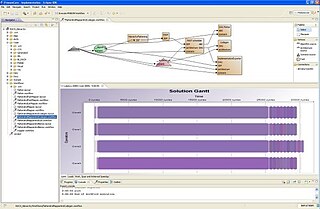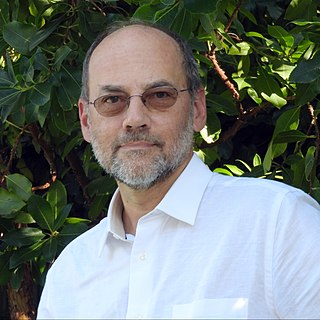
In computing and in systems theory, FIFO is an acronym for first in, first out, a method for organizing the manipulation of a data structure where the oldest (first) entry, or "head" of the queue, is processed first.

Static random-access memory is a type of random-access memory (RAM) that uses latching circuitry (flip-flop) to store each bit. SRAM is volatile memory; data is lost when power is removed.
In computer engineering, a hardware description language (HDL) is a specialized computer language used to describe the structure and behavior of electronic circuits, and most commonly, digital logic circuits.
In electronics and especially synchronous digital circuits, a clock signal is an electronic logic signal which oscillates between a high and a low state at a constant frequency and is used like a metronome to synchronize actions of digital circuits. In a synchronous logic circuit, the most common type of digital circuit, the clock signal is applied to all storage devices, flip-flops and latches, and causes them all to change state simultaneously, preventing race conditions.

Pure Data (Pd) is a visual programming language developed by Miller Puckette in the 1990s for creating interactive computer music and multimedia works. While Puckette is the main author of the program, Pd is an open-source project with a large developer base working on new extensions. It is released under BSD-3-Clause. It runs on Linux, MacOS, iOS, Android and Windows. Ports exist for FreeBSD and IRIX.
Signal programming is used in the same sense as dataflow programming, and is similar to event-driven programming.
In computer programming, dataflow programming is a programming paradigm that models a program as a directed graph of the data flowing between operations, thus implementing dataflow principles and architecture. Dataflow programming languages share some features of functional languages, and were generally developed in order to bring some functional concepts to a language more suitable for numeric processing. Some authors use the term datastream instead of dataflow to avoid confusion with dataflow computing or dataflow architecture, based on an indeterministic machine paradigm. Dataflow programming was pioneered by Jack Dennis and his graduate students at MIT in the 1960s.
Dataflow architecture is a dataflow-based computer architecture that directly contrasts the traditional von Neumann architecture or control flow architecture. Dataflow architectures have no program counter, in concept: the executability and execution of instructions is solely determined based on the availability of input arguments to the instructions, so that the order of instruction execution may be hard to predict.
Asynchronous circuit is a sequential digital logic circuit that does not use a global clock circuit or signal generator to synchronize its components. Instead, the components are driven by a handshaking circuit which indicates a completion of a set of instructions. Handshaking works by simple data transfer protocols. Many synchronous circuits were developed in early 1950s as part of bigger asynchronous systems. Asynchronous circuits and theory surrounding is a part of several steps in integrated circuit design, a field of digital electronics engineering.
In computer science, asynchronous I/O is a form of input/output processing that permits other processing to continue before the transmission has finished. A name used for asynchronous I/O in the Windows API is overlapped I/O.
A synchronous programming language is a computer programming language optimized for programming reactive systems. Computer systems can be sorted in three main classes: (1) transformational systems that take some inputs, process them, deliver their outputs, and terminate their execution; a typical example is a compiler; (2) interactive systems that interact continuously with their environment, at their own speed; a typical example is the web; and (3) reactive systems that interact continuously with their environment, at a speed imposed by the environment; a typical example is the automatic flight control system of modern airplanes. Reactive systems must therefore react to stimuli from the environment within strict time bounds. For this reason they are often also called real-time systems, and are found often in embedded systems.

A Kahn process network is a distributed model of computation in which a group of deterministic sequential processes communicate through unbounded first in, first out channels. The model requires that reading from a channel is blocking while writing is non-blocking. Due to these key restrictions, the resulting process network exhibits deterministic behavior that does not depend on the timing of computation nor on communication delays.
Concurrent computing is a form of computing in which several computations are executed concurrently—during overlapping time periods—instead of sequentially—with one completing before the next starts.
The primary focus of this article is asynchronous control in digital electronic systems. In a synchronous system, operations are coordinated by one, or more, centralized clock signals. An asynchronous system, in contrast, has no global clock. Asynchronous systems do not depend on strict arrival times of signals or messages for reliable operation. Coordination is achieved using event-driven architecture triggered by network packet arrival, changes (transitions) of signals, handshake protocols, and other methods.
In computer programming, flow-based programming (FBP) is a programming paradigm that defines applications as networks of "black box" processes, which exchange data across predefined connections by message passing, where the connections are specified externally to the processes. These black box processes can be reconnected endlessly to form different applications without having to be changed internally. FBP is thus naturally component-oriented.

PREESM is an open-source rapid prototyping and code generation tool. It is primarily employed to simulate signal processing applications and generate code for multi-core Digital Signal Processors. PREESM is developed at the Institute of Electronics and Telecommunications-Rennes (IETR) in collaboration with Texas Instruments France in Nice.
MLDesigner is an integrated modeling and simulation tool for the design and analysis of complex embedded and networked systems. MLDesigner speeds up modeling, simulation and analysis of discrete event, discrete time and continuous time systems concerning architecture, function and performance. The tools is based on ideas of the "Ptolemy Project", done at the University if California Berkeley. MLDesigner is developed by MLDesign Technologies Inc. Palo Alto, CA, USA in collaboration with Mission Level Design GmbH, Ilmenau, Germany.
Globally asynchronous locally synchronous (GALS), in electronics, is an architecture for designing electronic circuits that addresses the problem of safe and reliable data transfer between independent clock domains. GALS is a model of computation that emerged in the 1980s. It allows to design computer systems consisting of several synchronous islands interacting with other islands using asynchronous communication, e.g. with FIFOs.
SIGNAL is a programming language based on synchronized data-flow : a process is a set of equations on elementary flows describing both data and control.

Edward Ashford Lee is an American computer scientist, electrical engineer, and author. He is Professor of the Graduate School and Robert S. Pepper Distinguished Professor Emeritus in the Electrical Engineering and Computer Science (EECS) Department at UC Berkeley. Lee works in the areas of cyber-physical systems, embedded systems, and the semantics of programming languages. He is particularly known for his advocacy of deterministic models for the engineering of cyber-physical systems.





